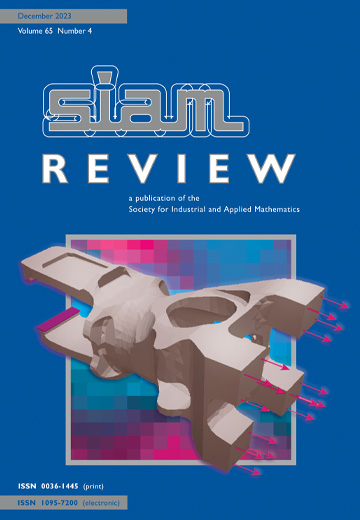Survey and Review
IF 6.1
1区 数学
Q1 MATHEMATICS, APPLIED
引用次数: 0
Abstract
SIAM Review, Volume 66, Issue 4, Page 617-617, November 2024.Neural oscillations are periodic activities of neurons in the central nervous system of eumetazoa. In an oscillatory neural network, neurons are modeled by coupled oscillators. Oscillatory networks are employed for describing the behavior of complex systems in biology or ecology with respect to the connectivity of the network components or the nonlinear dynamics of the individual units. Phase-locked periodic states and their instabilities are core features in the analysis of oscillatory networks. In “Oscillatory Networks: Insights from Piecewise-Linear Modeling,” Stephen Coombes, Mustafa Şayli, Rüdiger Thul, Rachel Nicks, Mason A. Porter, and Yi Ming Lai review techniques for studying coupled oscillatory networks. They first discuss phase reductions, phase-amplitude reductions, and the master stability function for smooth dynamical systems. Then they consider nonsmooth piecewise-linear (PWL) systems, for which periodic orbits are easily obtained. Saltation operators are used for modeling the propagation of perturbations through switching manifolds in the analysis of the dynamics and bifurcations at the network level. Applications to neural systems, cardiac systems, networks of electromechanical oscillators, and cooperation in cattle herds illustrate the power of these methods. PWL modeling has been applied for a long time in engineering. Recently, it has been introduced in other fields, such as social sciences, finance, and biology. For many modern applications in science, piecewise models are much more versatile than the classical smooth dynamical systems. In neuroscience, PWL functions enable explicit calculations which are infeasible in the original smooth system. This includes discontinuous dynamical systems, which are used to model impacting mechanical oscillators, integrate-and-fire models of spiking neurons, and cardiac oscillators. On the other hand, the price to pay is the retrieval of new conditions for the existence, uniqueness, and stability of solutions. The paper discusses the application of PWL models to a large variety of applications from engineering and biology. It will be of interest to many readers.
调查和审查
SIAM Review》,第 66 卷第 4 期,第 617-617 页,2024 年 11 月。 神经振荡是真尾目动物中枢神经系统中神经元的周期性活动。在振荡神经网络中,神经元由耦合振荡器建模。振荡网络用于描述生物学或生态学中复杂系统的行为,涉及网络组件的连接性或单个单元的非线性动态。锁相周期状态及其不稳定性是振荡网络分析的核心特征。在《振荡网络:中,Stephen Coombes、Mustafa Şayli、Rüdiger Thul、Rachel Nicks、Mason A. Porter 和 Yi Ming Lai 回顾了研究耦合振荡网络的技术。他们首先讨论了平滑动力系统的相位还原、相幅还原和主稳定函数。然后,他们考虑了非光滑的片线性 (PWL) 系统,对于这些系统,周期轨道很容易获得。在分析网络层面的动力学和分岔时,盐化算子用于模拟扰动通过开关流形的传播。在神经系统、心脏系统、机电振荡器网络和牛群合作中的应用说明了这些方法的威力。PWL 建模在工程领域应用已久。最近,它又被引入其他领域,如社会科学、金融和生物学。对于许多现代科学应用来说,片断模型比经典的平滑动态系统用途更广。在神经科学中,PWL 函数可以进行在原始平稳系统中不可行的显式计算。这包括用于模拟冲击机械振荡器、尖峰神经元的积分-发射模型和心脏振荡器的非连续动力系统。另一方面,所付出的代价是要检索解的存在性、唯一性和稳定性的新条件。本文讨论了 PWL 模型在工程学和生物学中的大量应用。它将引起许多读者的兴趣。
本文章由计算机程序翻译,如有差异,请以英文原文为准。
求助全文
约1分钟内获得全文
求助全文
来源期刊

SIAM Review
数学-应用数学
CiteScore
16.90
自引率
0.00%
发文量
50
期刊介绍:
Survey and Review feature papers that provide an integrative and current viewpoint on important topics in applied or computational mathematics and scientific computing. These papers aim to offer a comprehensive perspective on the subject matter.
Research Spotlights publish concise research papers in applied and computational mathematics that are of interest to a wide range of readers in SIAM Review. The papers in this section present innovative ideas that are clearly explained and motivated. They stand out from regular publications in specific SIAM journals due to their accessibility and potential for widespread and long-lasting influence.
 求助内容:
求助内容: 应助结果提醒方式:
应助结果提醒方式:


